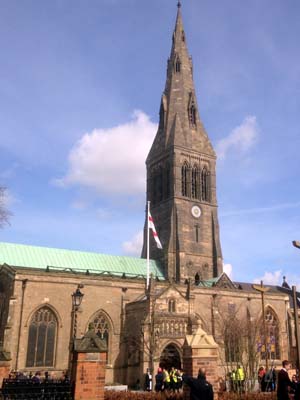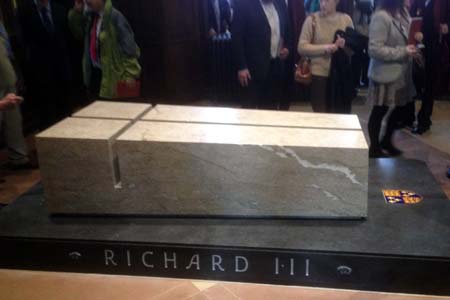| |
 |
 |
 |
| Comment on this report, or find other reports. |
 |
| Our Mystery Worshippers are volunteers who warm church pews for us around the world. If you'd like to become a Mystery Worshipper, start here. |
 |
| Find out how to reproduce this report in your church magazine or website. |
|
|
| 2833: Reveal of the Tomb of King Richard III: Leicester Cathedral, Leicester, England |
 |
 |
 |
Mystery Worshipper: Jon D. Babdist.
The church: Cathedral Church of St Martin, Leicester, England.
Denomination: Church of England, Diocese of Leicester.
The building: The Norman Church of St Martin dates to about 1086 and replaces an older Saxon structure. Most of what stands on the site today is a Gothic-appearing Victorian restoration of the Norman building. It was made a collegiate church in 1922 and a cathedral in 1926, when the present-day Diocese of Leicester was established. The original diocese, established in 680, was dissolved during the invasion of the Danes and the establishment of the Danelaw in 886. During the next thousand or so years the bishop's seat was moved first to Dorchester, then to Lincoln, and then to Peterborough, where it remained until 1926. Set in pleasant greenery, with a Norman tower and many statues in the walls, the cathedral is impressive without being overwhelming. There is a large nave, chancel, and four side chapels. The south porch, known as the Vaughan Porch in memory of a set of 19th century vicars all from that family, features seven figures in sandstone niches. A ring of 13 bells includes the so-called pancake bell, traditionally rung on Shrove Tuesday to warn housewives to use up all their lard and meat drippings before the beginning of Lent by making pancakes.
The church: Today the cathedral sponsors a number of activities well documented on their website. I'll just mention one of special interest: After18, an organisation that works with youths who have been separated from their families and are seeking asylum in England. Quoting from their website, After18 is "a trusted source of information for young people [helping them to] understand what is happening, consider their options and plan for their future ... offering information ... and arranging activities ... to socialise, have fun and learn new skills."
The neighbourhood: Leicester, in the Midlands, was an important Roman settlement, and the Romans uncovered ruins dating back to the Iron Age. After the Danish invasion, it was a major city of the Danelaw. Lady Jane Grey was born here, Cardinal Wolsey died here, and King Richard III was buried here – although the exact location of his earthly remains was a topic of dispute until a skeleton, subsequently verified to be that of His Majesty, was discovered under a car park in 2012. Today's service of reveal culminated a week of pageantry and drama. As I parked the Babdistmobile and strolled into the city centre, I noticed large terra cotta pots seemingly everywhere, each containing a big fat candle. I felt non-conformist horror arising within me, but bravely pressed on.
The cast: The service was led by the Rt Revd Tim Stevens, Bishop of Leicester, with the Very Revd David Monteith, Dean of Leicester, preaching. Other canon clergy read various parts of the service.
The date & time: Friday, 27 March 2015, 12.00pm.
What was the name of the service?
Service of Reveal of the Tomb and Celebration for King Richard III by the Grace of God King of England and France and Lord of Ireland. (A bit of a mouthful.)
How full was the building?
It was heaving. Rammed. Which is no surprise, as over 20,000 applied in the ballot to attend, and I was one of the 200 lucky plebes who got to join 500 of the great and the good.
Did anyone welcome you personally?
Why, yes, indeed! There were more volunteers and security officials than you could count. I was greeted at the front gate, my invitation was checked, and I joined the queue. We were all chatting away, reveling in our satisfaction that the odds had been in our favour. One chap next to me was there thanks to his wife, who had applied for him and for herself. He got in; she didn't. There's no justice in the world, is there? When we finally got through the doors, we were shown to our seats and reminded to stay put for the duration. An excellent order of service was on the seat. There are several on Ebay by now, I would guess!
Was your pew comfortable?
I was located in the side chapel, facing the as-yet unrevealed tomb of Richard III, so actually less than ten metres from the action. The seating here was of the moulded wooden type of chair, with steel legs, all locked together. Neither luxury nor agony, quite reasonable. Someone assured me that the pews were worse!
How would you describe the pre-service
atmosphere?
There was an excited hum and a buzz about the place. As we were seated a full 40 minutes before the event began, we had to amuse ourselves, and so I entered into a considerable conversation with my neighbour about nonconformity and the differences between Baptists and Congregationalists, and also the surviving groupings of these churches today. How we got on to this is hard to tell, but I know we began in thinking about how the death of Richard III set in motion the ascendancy of the Tudors, and the Reformation in England.
I tried to resist the rising urge to say rather loudly, "Of course, we all know that Blackadder killed him!"
The capable organist entertained us with some fine classical pieces as the time for the service drew closer.
What were the exact opening words of the
service?
"O God, make speed to save us."
What books did the congregation use during the
service?
Everything was contained within the maroon and gold order of service: hymns and songs with musical score (top marks for that), all sentences and responses and readings. Everything really, except the full text of the sermon.
What musical instruments were played?
The 1930 Harrison and Harrison Organ, and at least one trumpet. There may have been more, but the musicians were out of my sight.
Did anything distract you?
Yes! Quentin Rayner, a reporter for the BBC's news programme East Midlands Today, wandering around during proceedings swigging from a water bottle. As his camera crew searched out good angles during the service, they finished blocking what little view we had.

Was the worship stiff-upper-lip, happy clappy, or
what?
Well, it was very formal really. It was heavy on readings from scripture, heavy on prayer, and decidedly heavy on pomp and circumstance. There were drama performances woven into the service accompanied by all sorts of modern music. As for what we sang, there were hymns by various writers, mostly 20th century, of which I knew none but the last: Henry Williams Baker's "O praise ye the Lord." So I made up for the other ones by belting it out. Let it be know that there was a Baptist in the building! The singing was pretty quiet from the congregation in general, but I genuinely doubt that many people knew any of the hymns apart from the last one.
Exactly how long was the sermon?
14 minutes.
On a scale of 1-10, how good was the preacher?
5 – The dean was out of my line of sight. But there's no faulting his delivery, and it cannot be said that the contents of the sermon were dull! But you know, I couldn't tell you what the dean actually believes. If I had been sure of what message he had for us, or where he stood, even if I hated it, I would have given him at least one more point, but it was a sickly-sweet Anglican fudge.
In a nutshell, what was the sermon
about?
He began by quoting Revelation 21:4 (God shall wipe away all tears) and then moved into peregrine falcons and the messages that tombs can convey. But all of a sudden he was into the Wars of the Roses and then, just as quickly, into all the places that the stones had come from that were used in King Richard's new tomb. Then he mentioned the contemporary philosopher Charles Taylor and his concept of the "punctual self," and in the next breath Anthony of Egypt and St Martin. Finally, he asked if we were indeed our brothers' and sisters' keepers, and finally here was God again wiping away all tears.
Which part of the service was like being in
heaven?
Two things: one could feel the excitement as the tomb was revealed. It was a quite magical moment, history before your eyes.
The other was the choir and their beautiful rendition of James MacMillan's O Radiant Dawn. As they raised the volume and harmony on the repeated call "Come!", my soul soared.
And which part was like being in... er... the other place?
Sitting there for minutes as music blared and the odd hand appeared waving over people's heads, as all sorts of drama and dance unfolded, and not being able to see any of it apart from the actual "reveal."
What happened when you hung around after the service looking lost?
Not possible in this context. We were directed to get up, take a walk around the tomb in the chancel, and make our way to the exit. On returning to the full light of a pleasant day, I was charmed to be handed a single stem rose adorned with a RIII logo by a volunteer as a memento of the day.
How would you describe the after-service
coffee?
If your invitation said you were invited, there were apparently refreshments in the diocesan buildings. We lucky 200 were not, of course, on that list! But hey, I got a rose.
How would you feel about making this church your regular (where 10 = ecstatic, 0 = terminal)?
0 – Nothing personal, but I am, after all, a Baptist, and I live a hundred miles away.
Did the service make you feel glad to be a
Christian?
I am always glad to be a Christian, but not specifically as a result of this service, no.
What one thing will you remember about all this in seven days' time?
They gave me a rose! Bless 'em! |
|
|
 |
 |
 |
| We rely on voluntary donations to stay online. If you're a regular visitor to Ship of Fools, please consider supporting us. |
 |
 |
 |
| The Mystery Pilgrim |
 |
| One of our most seasoned reporters makes the Camino pilgrimage to Santiago de Compostela in Spain. Read here. |
 |
 |
 |
| London churches |
 |
| Read reports from 70 London churches, visited by a small army of Mystery Worshippers on one single Sunday. Read here. |
| |
|
|
|
|


